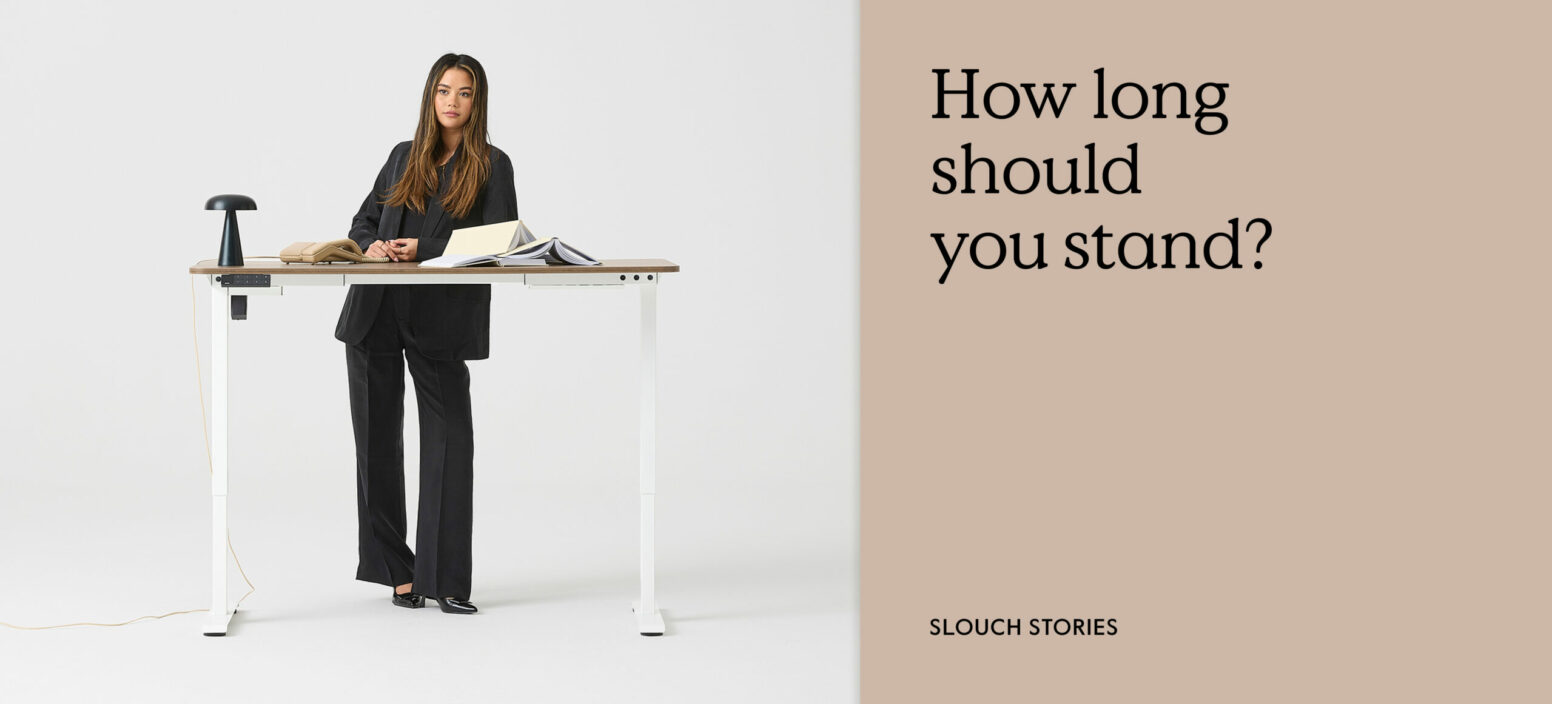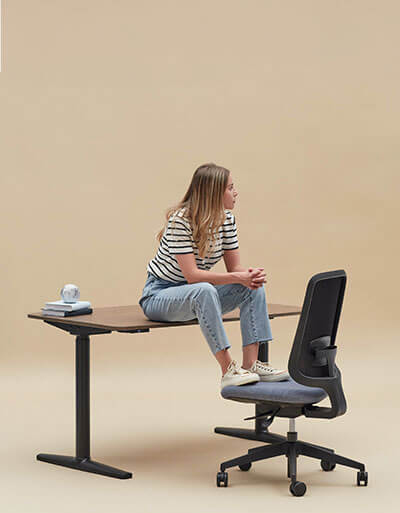How long should you stand at a standing desk? This is a great question, and one that many home office workers want to know when investing in ergonomic office equipment. Height adjusting desks are a brilliant modern staple to home workspaces, but simply owning one doesn’t ensure better posture. It’s important to know how to correctly use a standing desk and practice healthy standing habits to support your long-term health.
How long should you stand at a standing desk?
How long you decide to stand at your standing desk will depend on your own ability, comfort and routine. However, health experts have given guidance on how long you should be standing while working.
Professionals recommend standing for 15 to 30 minutes every hour and then taking breaks by sitting down. This means for every 1-2 hours you spend sitting down, you should stand at your desk for 30 minutes to an hour.
To help make this more relatable to your workday, here’s a quick breakdown:
- 8 hours of working = 4-6 hours of sitting, 2-4 hours of standing, spread out across your day.
Why should you avoid sitting down all day?
Most of us office workers know how uncomfortable sitting at our desks all day is, but there are also more serious health problems that can arise from extended sitting. With the huge increase in hybrid and home working in recent years, many people find themselves working on the sofa or even WFB (working from bed), but this can cause some unpleasant health concerns.
The NHS has published a wide range of reasons on why we should sit less, with some of the associated risks including:
- Increased risk of back and neck pain.
- Posture problems and spinal alignment issues.
- Reduced circulation in the lower extremities.
- Higher risk of developing type 2 diabetes.
Unfortunately, when it comes to more professional or admin-based jobs, it’s usually impossible to avoid sitting for long periods. That’s why it’s especially important to invest in the right equipment and practice good posture tricks to help keep your body healthy.
Should you use a standing desk all day?
With all the information circling the internet on the adverse effects of prolonged sitting, many people think they need to cut out sitting at their desks altogether.
However, studies have found that prolonged standing is no better for your health than extended sitting and can cause issues like:
- Sore feet and lower limbs.
- Circulation issues, varicose veins and deep vein thrombosis.
- Increased fatigue.
- Joint discomfort, particularly in the knees and hips.
Is a standing desk good for you?
If you want to achieve the best balance for your health, then a standing desk is the perfect option. These desks have adjustable height settings that allow you to alternate between sitting and standing.
The benefits of a standing desk mean you can avoid issues associated with prolonged sitting, like back pain and poor circulation. You can then adjust your desk and rest using a supportive home office chair to reduce the fatigue associated with extended standing.
By alternating between these two forms of working, you’ll be able to keep your posture varied and your body active during usually stationary tasks.
Best practices for using a standing desk
To ensure you look after yourself and get the most out of your desk, it’s important to stand properly. Here are our top tips for ergonomic use:
1. Start your standing desk journey slowly
Don’t jump straight into standing for 30 minutes 5 times a day. This will most likely cause fatigue and strain if you’re not used to this drastic change from sitting. Gradually increase how often you stand, working up from 15 minutes every hour and so on until you can build up your tolerance over a few weeks.
2. Adjust your desk to the right height
To ensure the correct standing desk posture, adjust your desk so that your elbows rest at a 90-degree angle. Your monitor should be positioned at or slightly below eye level to avoid neck strain. If you’re on the taller side, you might need to invest in a monitor stand to level your monitor in line with your eyes. For a deep dive into ergonomic office setup, take a look at our detailed blog.
3. Use foot support
Don’t just work in socks or bare feet. Use an antifatigue mat or cushioning footwear to support your weight and the arches of your feet. This will help to minimise joint pain and strain.
4. Avoid locking your knees
When standing whilst working, always bend your knees slightly. This will stop your legs from getting stiff or feeling locked and also help keep blood flowing to your lower body.
5. Take breaks and move around
Don’t simply stand still for 30 minutes. Shift your weight from one side to the other, walk on the spot or do some simple ankle rolls. Any little movements will help to improve your circulation and stop you feeling fatigued.
Pair a standing desk with an ergonomic chair
To achieve the ultimate ergonomic setup, you don’t just need a standing desk. You also need to invest in a proper ergonomic chair that is designed to offer both comfort and support when sitting for extended periods.
Our comfy office chairs feature lumbar support, adjustable arms and height features so you can maintain good posture when sitting and standing.
When paired with a standing desk, a high-quality chair like ours will take the pressure off your back, hips and shoulders. When combined with regular movement, these premium office amenities will have a positive influence way past work productivity – they’ll help keep you healthy in the long term.
Effortless working when sitting or standing
At Slouch, we believe that wherever you’re working, your environment should adapt to you, not the other way around. Our range of ergonomic chairs and height adjustable desks are designed to support you throughout your workday.
Are you ready for more healthy working habits? Explore our collection of home office desks and find the right one for you.
Need personalised advice or help selecting the perfect desk setup? Contact us anytime at [email protected] and we’ll be happy to help.

